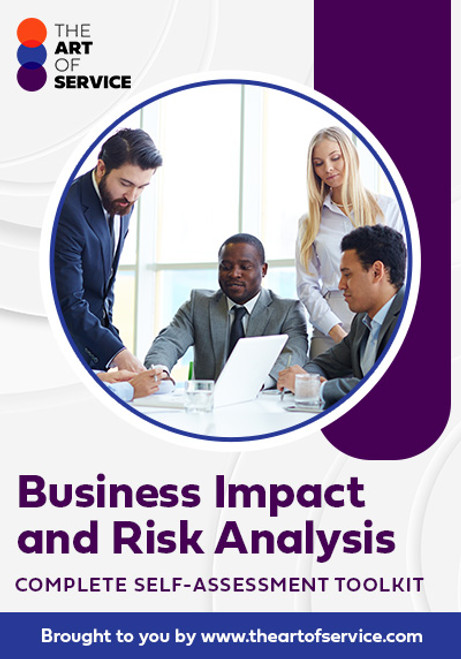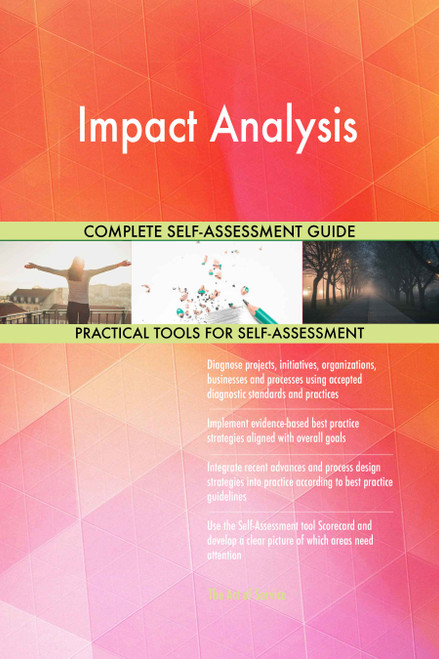Be accountable for working in conjunction with the Disaster Recovery program to identify opportunities to improve recovery solutions and arrangements with a focus on ensuring that Business Requirements are mapped to Disaster Recovery solutions.
More Uses of the Business Impact Analysis BIA Toolkit:
- Ensure you unite; lead cascading of the overall enterprise resiliency vision and objectives across Finance functions.
- Supervise: design, plan, organize, and conduct controlled exercises/tests on all plans and critical technologies.
- Collaborate closely with various DSS business units to serve as analytic account executive to ensure production of meaningful data products.
- Warrant that your enterprise provides Technical Support for enterprise (on premise) systems, middleware and administration tools.
- Be certain that your organization interacts with the Critical Business units at all levels of your organization and support groups for the purpose of assessing, planning, directing, controlling, and maintaining the Contingency Planning effort.
- Be accountable for developing the resilience strategy and Business Continuity framework that incorporates and reflects ongoing changes to the environment and Business Operations.
- Coordinate: proactively monitor and communicate budget, actual status, and forecast costs/labor hours for projects.
- Confirm your business develops and recommends Policies and Procedures regarding all areas of Human Resources Management.
- Align the Business Continuity Management program with the rapid growth of your organization and increasing Regulatory Requirements.
- Supervise: professionally conduct tasks in a manner complying with all consumer protection regulations and treats consumers fairly.
- Provide leadership in developing, assessing, coordinating and communicating Business Continuity program.
- Ensure continuity strategies and capabilities align with resiliency vision and objectives Finance.
- Manage work with business unIt Management to enhance Contingency Plans, mitigating the effect of a technology system or application failure or problem.
- Confirm your business ensures the timely, accurate and complete processing of personnel transactions and Records management.
- Provide direct communications between the BCP Office, Technology Teams, business units and support organizations.
- Methodize: proactively pull information from client Needs Analysis and work with account executives to understand client marketing objectives.
- Drive: regularly meet and gather feedback on the client schedules that built to understand necessary changes to improve future schedules.
- Collaborate with vendor Risk Management the review and monitoring of bcm preparedness with third parties, vendors, etc.
- Steer: technology, and Human Resources in compliance with applicable funding and Regulatory Requirements to achieve.
- Drive: partner with operations and Technology Teams to create and develop Recovery Plans to eliminate and reduce identified gaps.
- Ensure you collaborate; lead with expertise in Application Design/architecture, integration Architecture Development, enterprise Application Integration, and Integration Technologies solutions and standards.
- Create client and internal Status Reports that effectively communicate schedule status and identify critical path.
- Ensure the realization of the Business Strategies through technology and continued Process Improvements.
- Support Organizational Planning to address disasters, interruptions of Business Functions and enterprise resilience.
- Provide technical guidance to other Project Controls staff in schedule and Cost Control procedures.
- Consolidate performance data to support Performance Measurement, Data Analysis, and cost forecasting.
- Confirm your operation assess the impact of Business Process and Organizational Change on continuity plans and processes.
- Steer: review plans and specifications to ensure that work is in compliance with Project Plans and specifications.
- Devise: review and approves all departmental and divisional plans to ensure appropriate roll up to the system wide plan.
- Formulate: design stable, reliable and effective database objects and procedure based on Customer Requirements.
Save time, empower your teams and effectively upgrade your processes with access to this practical Business Impact Analysis BIA Toolkit and guide. Address common challenges with best-practice templates, step-by-step Work Plans and maturity diagnostics for any Business Impact Analysis BIA related project.
Download the Toolkit and in Three Steps you will be guided from idea to implementation results.
The Toolkit contains the following practical and powerful enablers with new and updated Business Impact Analysis BIA specific requirements:
STEP 1: Get your bearings
Start with...
- The latest quick edition of the Business Impact Analysis BIA Self Assessment book in PDF containing 49 requirements to perform a quickscan, get an overview and share with stakeholders.
Organized in a Data Driven improvement cycle RDMAICS (Recognize, Define, Measure, Analyze, Improve, Control and Sustain), check the…
- Example pre-filled Self-Assessment Excel Dashboard to get familiar with results generation
Then find your goals...
STEP 2: Set concrete goals, tasks, dates and numbers you can track
Featuring 999 new and updated case-based questions, organized into seven core areas of Process Design, this Self-Assessment will help you identify areas in which Business Impact Analysis BIA improvements can be made.
Examples; 10 of the 999 standard requirements:
- Is there a Work Around that you can use?
- What are the record-keeping requirements of Business Impact Analysis BIA activities?
- Who controls critical resources?
- Who needs budgets?
- How many trainings, in total, are needed?
- Think about some of the processes you undertake within your organization, which do you own?
- What Business Impact Analysis BIA data will be collected?
- What are your current levels and trends in key measures or indicators of workforce and leader development?
- Will the controls trigger any other risks?
- What is your theory of human motivation, and how does your Compensation Plan fit with that view?
Complete the self assessment, on your own or with a team in a workshop setting. Use the workbook together with the self assessment requirements spreadsheet:
- The workbook is the latest in-depth complete edition of the Business Impact Analysis BIA book in PDF containing 994 requirements, which criteria correspond to the criteria in...
Your Business Impact Analysis BIA self-assessment dashboard which gives you your dynamically prioritized projects-ready tool and shows your organization exactly what to do next:
- The Self-Assessment Excel Dashboard; with the Business Impact Analysis BIA Self-Assessment and Scorecard you will develop a clear picture of which Business Impact Analysis BIA areas need attention, which requirements you should focus on and who will be responsible for them:
- Shows your organization instant insight in areas for improvement: Auto generates reports, radar chart for maturity assessment, insights per process and participant and bespoke, ready to use, RACI Matrix
- Gives you a professional Dashboard to guide and perform a thorough Business Impact Analysis BIA Self-Assessment
- Is secure: Ensures offline Data Protection of your Self-Assessment results
- Dynamically prioritized projects-ready RACI Matrix shows your organization exactly what to do next:
STEP 3: Implement, Track, follow up and revise strategy
The outcomes of STEP 2, the self assessment, are the inputs for STEP 3; Start and manage Business Impact Analysis BIA projects with the 62 implementation resources:
- 62 step-by-step Business Impact Analysis BIA Project Management Form Templates covering over 1500 Business Impact Analysis BIA project requirements and success criteria:
Examples; 10 of the check box criteria:
- Cost Management Plan: Eac -estimate at completion, what is the total job expected to cost?
- Activity Cost Estimates: In which phase of the Acquisition Process cycle does source qualifications reside?
- Project Scope Statement: Will all Business Impact Analysis BIA project issues be unconditionally tracked through the Issue Resolution process?
- Closing Process Group: Did the Business Impact Analysis BIA Project Team have enough people to execute the Business Impact Analysis BIA Project Plan?
- Source Selection Criteria: What are the guidelines regarding award without considerations?
- Scope Management Plan: Are Corrective Actions taken when actual results are substantially different from detailed Business Impact Analysis BIA Project Plan (variances)?
- Initiating Process Group: During which stage of Risk planning are risks prioritized based on probability and impact?
- Cost Management Plan: Is your organization certified as a supplier, wholesaler, regular dealer, or manufacturer of corresponding products/supplies?
- Procurement Audit: Was a formal review of tenders received undertaken?
- Activity Cost Estimates: What procedures are put in place regarding bidding and cost comparisons, if any?
Step-by-step and complete Business Impact Analysis BIA Project Management Forms and Templates including check box criteria and templates.
1.0 Initiating Process Group:
- 1.1 Business Impact Analysis BIA project Charter
- 1.2 Stakeholder Register
- 1.3 Stakeholder Analysis Matrix
2.0 Planning Process Group:
- 2.1 Business Impact Analysis BIA Project Management Plan
- 2.2 Scope Management Plan
- 2.3 Requirements Management Plan
- 2.4 Requirements Documentation
- 2.5 Requirements Traceability Matrix
- 2.6 Business Impact Analysis BIA Project Scope Statement
- 2.7 Assumption and Constraint Log
- 2.8 Work Breakdown Structure
- 2.9 WBS Dictionary
- 2.10 Schedule Management Plan
- 2.11 Activity List
- 2.12 Activity Attributes
- 2.13 Milestone List
- 2.14 Network Diagram
- 2.15 Activity Resource Requirements
- 2.16 Resource Breakdown Structure
- 2.17 Activity Duration Estimates
- 2.18 Duration Estimating Worksheet
- 2.19 Business Impact Analysis BIA project Schedule
- 2.20 Cost Management Plan
- 2.21 Activity Cost Estimates
- 2.22 Cost Estimating Worksheet
- 2.23 Cost Baseline
- 2.24 Quality Management Plan
- 2.25 Quality Metrics
- 2.26 Process Improvement Plan
- 2.27 Responsibility Assignment Matrix
- 2.28 Roles and Responsibilities
- 2.29 Human Resource Management Plan
- 2.30 Communications Management Plan
- 2.31 Risk Management Plan
- 2.32 Risk Register
- 2.33 Probability and Impact Assessment
- 2.34 Probability and Impact Matrix
- 2.35 Risk Data Sheet
- 2.36 Procurement Management Plan
- 2.37 Source Selection Criteria
- 2.38 Stakeholder Management Plan
- 2.39 Change Management Plan
3.0 Executing Process Group:
- 3.1 Team Member Status Report
- 3.2 Change Request
- 3.3 Change Log
- 3.4 Decision Log
- 3.5 Quality Audit
- 3.6 Team Directory
- 3.7 Team Operating Agreement
- 3.8 Team Performance Assessment
- 3.9 Team Member Performance Assessment
- 3.10 Issue Log
4.0 Monitoring and Controlling Process Group:
- 4.1 Business Impact Analysis BIA project Performance Report
- 4.2 Variance Analysis
- 4.3 Earned Value Status
- 4.4 Risk Audit
- 4.5 Contractor Status Report
- 4.6 Formal Acceptance
5.0 Closing Process Group:
- 5.1 Procurement Audit
- 5.2 Contract Close-Out
- 5.3 Business Impact Analysis BIA project or Phase Close-Out
- 5.4 Lessons Learned
Results
With this Three Step process you will have all the tools you need for any Business Impact Analysis BIA project with this in-depth Business Impact Analysis BIA Toolkit.
In using the Toolkit you will be better able to:
- Diagnose Business Impact Analysis BIA projects, initiatives, organizations, businesses and processes using accepted diagnostic standards and practices
- Implement evidence-based Best Practice strategies aligned with overall goals
- Integrate recent advances in Business Impact Analysis BIA and put Process Design strategies into practice according to Best Practice guidelines
Defining, designing, creating, and implementing a process to solve a business challenge or meet a business objective is the most valuable role; In EVERY company, organization and department.
Unless you are talking a one-time, single-use project within a business, there should be a process. Whether that process is managed and implemented by humans, AI, or a combination of the two, it needs to be designed by someone with a complex enough perspective to ask the right questions. Someone capable of asking the right questions and step back and say, 'What are we really trying to accomplish here? And is there a different way to look at it?'
This Toolkit empowers people to do just that - whether their title is entrepreneur, manager, consultant, (Vice-)President, CxO etc... - they are the people who rule the future. They are the person who asks the right questions to make Business Impact Analysis BIA investments work better.
This Business Impact Analysis BIA All-Inclusive Toolkit enables You to be that person.
Includes lifetime updates
Every self assessment comes with Lifetime Updates and Lifetime Free Updated Books. Lifetime Updates is an industry-first feature which allows you to receive verified self assessment updates, ensuring you always have the most accurate information at your fingertips.







